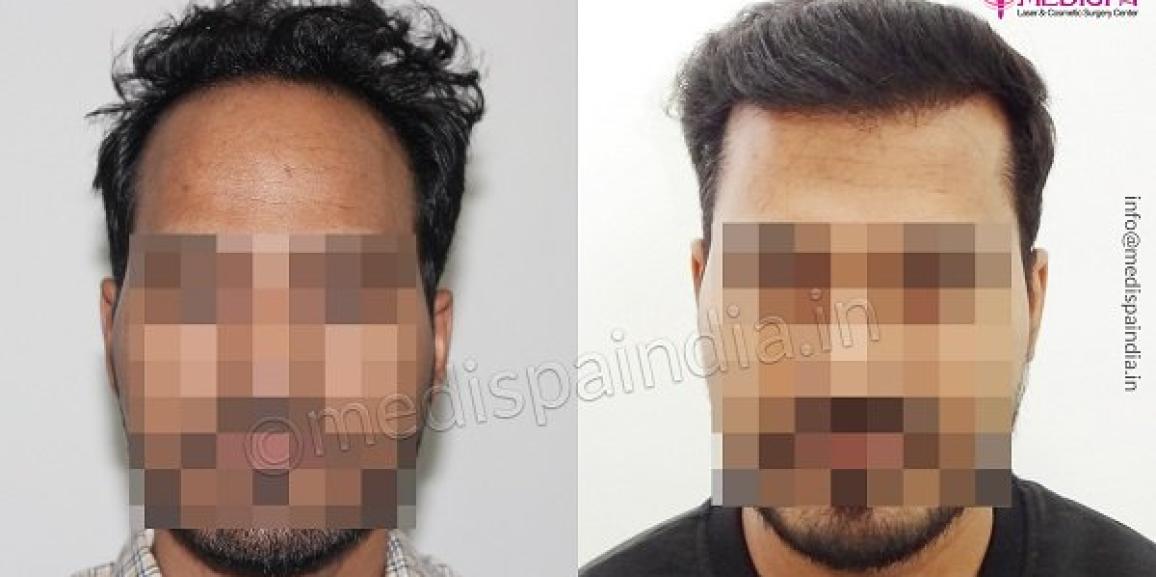
Are you experiencing hair loss and seeking a long-term cure?
Let’s find out what kind of baldness you have to begin with!
Permanent hair loss requires medical assistance, whereas temporary hair loss does not, and can be either temporary or permanent. Let’s talk especially about pattern baldness, one of the most prevalent types of baldness.
Causes of baldness
Genetic baldness and androgenic alopecia are other names for pattern baldness. Hair follicles that are oversensitive and genetically defective are what cause baldness. These oversensitive androgenic hormone-resistant hair follicles experience hair thinning or shrinkage. Hair loss results from hair thinning or miniaturisation, and the ongoing cycle causes an area of baldness to develop.
Male hair loss typically starts as a bald patch or a receding hairline around the vertex. By combining the patches, the bald area may get worse and affect a larger area. When baldness is advanced, the scalp is completely gone, leaving a ring of hair on the sides and back of the head.
The pattern of female baldness exhibits a clear pattern. The first signs of hair loss are central thinning, which spreads by expanding the partition but typically does not result in baldness.
Stages of baldness
The Norwood categorization system is the most used method for listing the stages of baldness. The stages of baldness are described here:
Class I: Entire hairline lies high on the forehead and is not actually balding.
Class II: Triangular areas of recession in the sides of frontal area and minimal recession on mid frontal area.
Class III: Borderline case. Deepening of triangular recession or can include thinning of hair on the vertex.
Class IV: Further frontal hair loss and widening of hair loss from vertex but still a wide band of hair present separating frontal and vertex hair loss.
Class V: Widening of frontal and vertex hair loss and continual breaking of separation line of hairs between frontal and vertex baldness.
Class VI: Band or bridge of hair disappear merging frontal and vertex baldness.
Class VII: A band ofhair presents only in back and side of the head.
Hair transplant: process and recovery
Three basic steps in the hair transplant method are as follows:
- Making a choice for the hair grafts: The hair follicles that will be extracted for the hair transplant are chosen and particularly chosen depending on the hair follicles’ characteristics. The hair follicles have to be virtually indestructible or resistant to DHT. The back and sides of the head, the chest, the axilla, the beard, or the pubic region are where the best hair follicles are chosen.
- Hair graft harvesting is done under high magnification and the selected grafts are taken from the donor location. Either the FUT technique or the FUE technique is used to harvest the hair follicles. A strip from the donor area is removed during a FUT hair transplant procedure, and the strip is subsequently dissected to collect the individual hair follicles. After that, the donor area is sutured back together for a painless healing. The individual hair grafts are instead removed from the donor area using a punch-like device in the FUE process.
- Hair follicle transplantation: Following the harvesting of the hair grafts, hair follicles are carefully and cautiously implanted in the targeted bald area.
The majority of people may be concerned about their recovery from hair transplants. It gets challenging to find time in your busy routine. However, a minimally invasive procedure like a hair transplant is unquestionably simple. After the surgery, you don’t need to stay in bed for several days. In fact, you can get back to your regular schedule the day after the treatment.
You might experience a few side effects, such as little soreness, itching, or forehead swelling. But a short time after the treatment, these side effects go away. The best way to prevent them is to take the safeguards your doctor has advised.
Therefore, it is advisable to speak with a real doctor to discuss your fear and get the best advice.
How hair transplant can help?
The hair transplant surgery has become very popular due to its many advantages. The most popular destination for hair transplant tourism is now India. In India, hair transplant in Jaipur and Delhi have made more advancements than other regions of the nation. The excellent news is that hair transplant cost in Jaipur is really inexpensive.
For its top-notch treatments, Medispa hair transplant clinics in Delhi and Jaipur are well-known. We offer amenities that are comparable to those seen in renowned worldwide clinics. You will have a safe and excellent hair transplant thanks to our professional guidance and customised care. We are dedicated to our job and fervently committed to offering first-rate services.
You can surely get rid of your baldness problem with a hair transplant. The hair transplant treatment can permanently reverse your balding. This is a long-term fix for your hair loss issue. You may also think of it as a one-time investment for your issue with hair loss.
With the aid of cutting-edge procedures, hair transplantation gives you the greatest chance of hair growth. The outcomes of the surgery are extremely natural-looking, which is the icing on the cake. The best treatment option for baldness to date is hair transplantation.
Choosing the best clinic and specialist to perform the hair transplant is the only way to ensure that you have the best results from the process.







